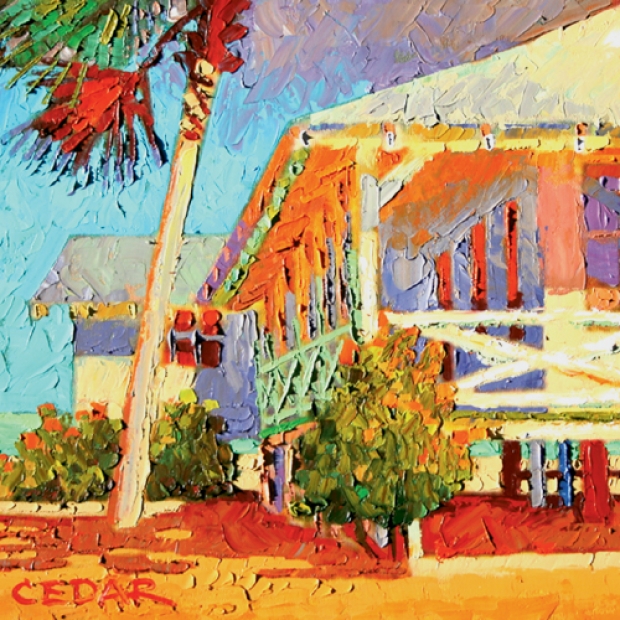
Many Grand Strand residents and visitors have passed The Sign Man on U.S. 17 in North Myrtle Beach, a business established in 1983 specializing in personalized, sand-blasted signs for beach homes. Yet most are unaware that the Sign Man himself also devotes his time, his talent and his heart to a very different kind of art work. Steve Jameson’s representations of iconic Myrtle Beach landscapes provide a lasting impression of the Grand Strand’s cultural history and evolution.
“This is where I’ve lived for 31 years,” explains Jameson. “I’ve really come to love the Grand Strand and the South Carolina coast. And part of loving it, as an artist—I just really want to paint it.”
And so he does. Jameson has painted scores of old, original beach homes up and down the Strand, mostly in Pawleys Island and Myrtle Beach. He spends hours surveying each structure, analyzing its composition, color, light and space to create an authentic watercolor depiction conveying a specific time and place. Most of the houses he’s painted have since been torn down. “It’s really sad,” Jameson notes. “People don’t appreciate what they’ve got. I love old Myrtle Beach.” However, he explains, through his artwork, the structures endure—a timeless tribute to the Grand Strand’s earliest days.
Jameson was also around during the final hurrah of the Myrtle Beach Pavilion, before it closed in 2007. As the “heart of Myrtle Beach,” the Pavilion, Jameson knew, held meaningful memories for thousands of area residents. He was there to document and immortalize that moment.
“I wanted to go catch the memories, so I took a lot of photographs,” he says. “It was a magical hour because there was a sunset—really nice, strong sunset color—but the carnival lights had simultaneously been turned on, so it wasn’t dark night yet. You weren’t just with the carnival lights and you weren’t just with the sunset—you had them both. So it was really magical.” The acrylic paintings that resulted from those photographs render a scene both nostalgic and playful, artistically capturing the mood on that last night of original Myrtle Beach fun.
While the Grand Strand is one of Jameson’s favorite subjects, capturing it is far from his sole artistic endeavor. Jameson is a prolific artist who’s nabbed the top prizes in the Waccamaw Arts Guild annual show and other juried exhibitions around the country. He’s a member of the esteemed National Watercolor Society and has won awards at multiple association events, in addition to illustrating four children’s books and cover art for three music CDs. He paints beach homes in Key West in addition to Grand Strand locations, and his media range from oil on canvas to watercolor to acrylic to palette knife. His work is on display at galleries in Charleston, Wilmington, Calabash and Key West.
Michael Golonka, owner of the Racine Gallery in Wilmington, appreciates Jameson’s technique and talent in palette knife media. “Steve gives all of his work a fresh, tropical vibe while looking like it was just finished a few minutes ago,” Golonka says. “Most people don’t realize it takes about 6 months plus to dry because of the heavy oil paint. His works take us all away, maybe even just for but a second, to that special place. The way he uses a brilliant color palette, carefully incorporating it into his subject matter, is very striking.”
Inside The Sign Man, which doubles as Jameson’s studio, visitors immediately feel the artistic sensibility that permeates the environment. Jameson’s canvases hang on and are piled along the walls, a bird cage rests on a wide desk, and a dog (one of the artist’s two life companions since two others passed away last year) sleeps underneath. Muted lighting and New Age music complete the scene. As Jameson discusses his work, he considers his own temperament in exploring the reason he paints beach houses.
“I think they express something about my spirit,” he says. “I’m a real loner—a lone wolf kind of person. I have lots of friends, but I spend much of my time alone. I think a lone beach house is almost like a spiritual aspirant that’s gone to the edge of the earth, as far as you can get, away from society and as close as you can get to the ocean, which would seem to symbolize spirituality. And I’m just there alone, enjoying the community of the ocean and being quiet. I think that’s why I keep painting beach houses. Because that’s sort of an illustration of who I am internally.”
Jameson’s allonym is also rooted in the characteristics of spirituality and introspection. He paints under the name “Cedar,” partially in reverence to the tree and partially as a symbolic representation of himself. “My dad used to carve things out of cedar, and I used to love the smell. When I first started painting, I didn’t feel comfortable using my name, Steve Jameson. It just didn’t seem like an artist name; it seemed like a businessman or something. The name Cedar also has to do with being private, introverted; I’d rather have an art name out there on my artwork instead of me.”
Whether it’s Cedar or the Sign Man or Steve Jameson, this artist’s work provides a beautiful and lasting link to the days of old Myrtle Beach.